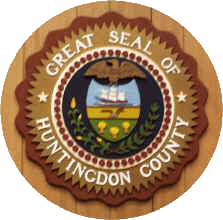About Us
About Us
County Government in Pennsylvania is actually older than the nation itself. As one of the original thirteen colonies Pennsylvania had a Provincial Assembly and Governor. From time-to-time communities would petition the Assembly to create additional counties to facilitate legal transactions and trade. The first counties in Pennsylvania were established in 1682 by William Penn.
Huntingdon County was established on the 20th day of September 1787. It had been created out of Bedford County, which in turn had been part of Cumberland County. Land taken from Huntingdon County to form parts of Centre and Cambria Counties reduced the size of Huntingdon County, and on February 26, 1846, with the creation of Blair County from a portion of Huntingdon County, the present boundaries of the County were established.
Since the creation of the County, there have been three courthouses. The first Huntingdon County Court House was completed in 1797 and was located in the middle of Third Street on the south side of Penn Street in Huntingdon Borough. After outgrowing this structure and site, a second Court House was erected in 1842 on the site of the present structure, Penn Street between Second and Third Streets. The present Court House was designed by M.E. Beebe of Buffalo, New York in a French Renaissance style. The structure was completed in 1883, with major renovations occurring in the 1930's, a new clock tower, and 1972, addition of office space to the west side of the building and general remodeling to the entire building.
Counties are classified on the basis of population for the purpose of regulation of county government affairs. Counties are governed by the County Code of 1955, as amended, which covers third through eighth class counties. Huntingdon County, with a population of approximately 45,000, is a Sixth Class County. The County Code, supplemented by various other legislation in specific subject areas, is the basic law for administration of county affairs.
A county is primarily an agency of the state government (and sometimes the federal government) rather than a fully independent unit of local self-government. As an agent of the state government the county administers election laws, enforces state laws, and conducts courts of justice. The Pennsylvania General Assembly prescribes many of the operations and, therefore, the costs of county government. In addition to serving as an agent of the state, counties have been granted powers of self-government similar to cities, boroughs, and townships. In exercising these powers of self-government, counties are guided by the ideal of providing for the general welfare of county residents.
OTHER GOVERNMENTS IN HUNTINGDON COUNTY
Huntingdon County citizens are also served by a number of local governments. Municipal governments, with broad local governing powers, consist of boroughs and townships. Presently there are eighteen boroughs and thirty townships in the County. The townships are all governed by the Second Class Township Code and the boroughs by the Borough Code. Second Class Townships are governed by three elected Supervisors and Boroughs by an elected Mayor and Council. The County is served by six school districts. Each school district is governed by an elected School Board. In addition to these elected local governments, the County is served by a number of authorities. These authorities are created to perform specific functions and are governed by the Municipal Authorities Act of 1945.

